AUDI A5 COUPE 2016 Owners Manual
Manufacturer: AUDI, Model Year: 2016, Model line: A5 COUPE, Model: AUDI A5 COUPE 2016Pages: 264, PDF Size: 66.92 MB
Page 231 of 264
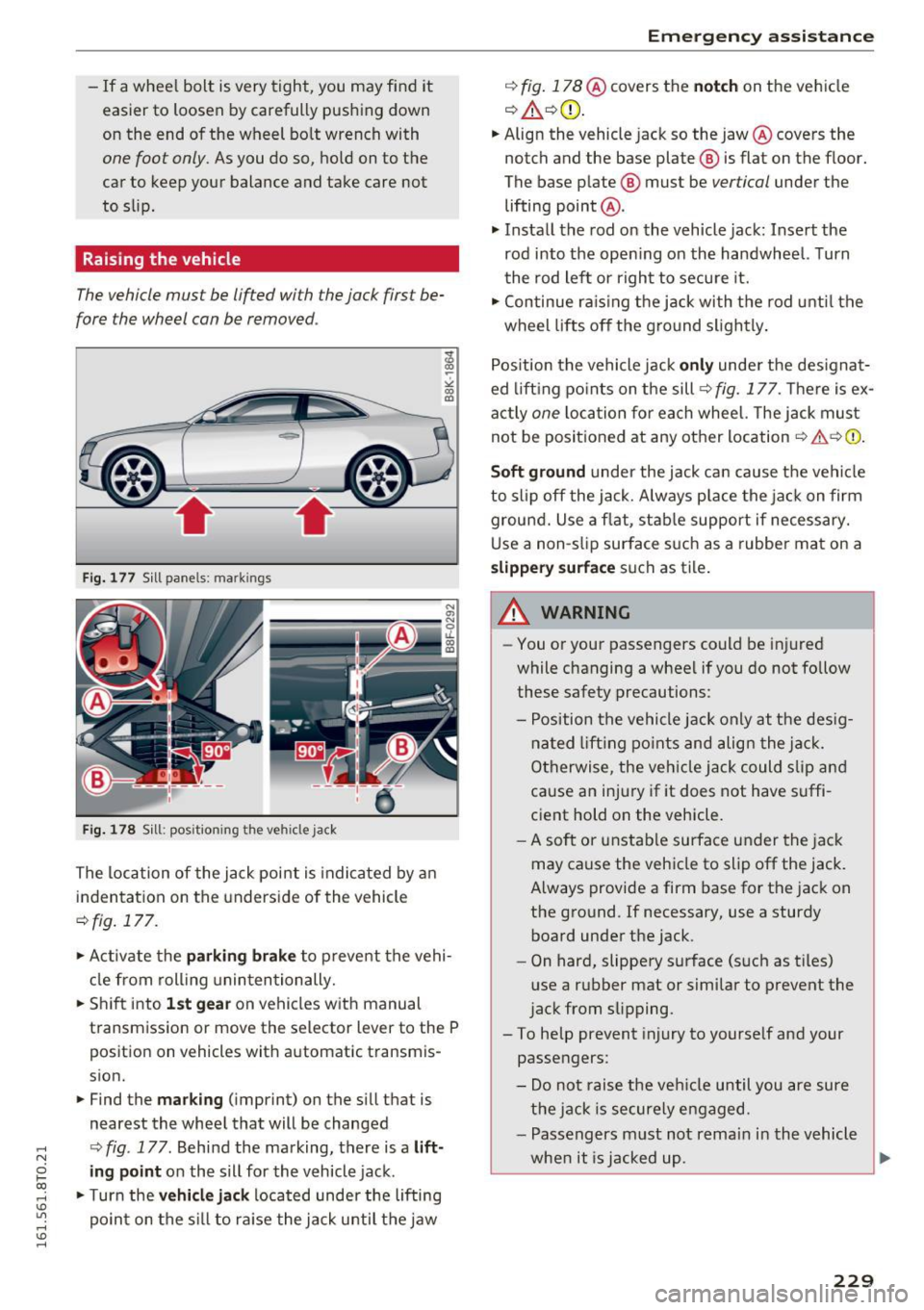
,-1 N
0 1-CX)
,-1 I.Cl U"I
,-1 I.Cl ......
-If a whee l bolt is very tight, you may find it
easier to loosen by carefully pushing down
on the end of the wheel bo lt wrench with
one foot only. As you do so, hold on to the
car to keep your balance and take care not
to slip.
Raising the vehicle
The vehicle must be li~ed with the jack first be
fore the wheel can be removed .
Fig. 177 Sill pane ls: mark ing s
Fig. 178 Sill: po sit ion in g the ve hicle jack
The location of the jack point is indicated by an
indentation on the underside of the vehicle
~ fig . 177 .
.,. Activate the parkin g brak e to prevent the vehi
cl e from roll ing unintentionally.
.,. Shift into
1st g ear on vehicles with manual
t ransm ission or
move the selector lever to the P
position on v ehicles with automatic transmis
sion.
.,. Find the
ma rki ng (imprint) on the sill that is
nearest the wheel that will be changed
~ fig . 177 . Behind the marking, there is a lift
ing point
on the sill for the vehicle jack .
.,. Turn the
vehi cle jack located under the lifting
po in t on the s ill to ra ise the jack until the jaw
Em ergen cy a ssis tanc e
~ fig. 178 @covers the notch on the ve hicle
~ A ~0 .
.,. Align the vehicle jack so the jaw@ covers the
notch and the base pla te ® is flat on the floor.
The base p late ® must be
vertical under the
lifting point @.
.,. Install the rod on the vehicle jack: Insert the
rod into the open ing o n the handwheel. Turn
the rod left or righ t to secu re it.
.,. Continue ra is ing the jack wi th the rod unti l the
wheel lifts off the ground slight ly .
Pos ition the vehicle jack
only unde r the des ignat
ed lift ing po ints on the sill
c:!> fig. 177 . There is ex
act ly
one l oca tion for each wheel. The jack must
not be positioned at any other location
c:!> &,. c:!>(D .
Soft ground under the jack ca n cause t he vehicle
to slip off the jack. A lways p lace the ja ck on firm
ground. Use a f lat, stab le support if necessary.
Use a non-s lip surface s uch as a rubbe r mat on a
slipper y surfa ce such as tile .
A WARNING
-
-You o r your passengers could be in jured
while changing a wheel if you do not follow
these safety precautions :
- Position the vehicle jack only at the des ig
na ted lift ing po ints and alig n the jack.
Otherwise, the veh icle jack could slip and
cause an injury if it does not have suffi
cient hold on the vehicle.
- A soft or unstab le surface under the jac k
may cause the vehicle to slip off the jack.
Always provide a firm base for the jack on
the ground. If necessary, use a sturdy board under the jack .
- On hard, slippery surface (s uch as tiles)
use a rubber mat or similar to prevent the
j ack from slipping.
- To help prevent in jury to yourse lf and your
passengers:
- Do not raise the ve hicle until you are sure
the jack is securely engaged.
- Passengers must not remai n in the vehicle
whe n it is jacked up .
~
229
Page 232 of 264
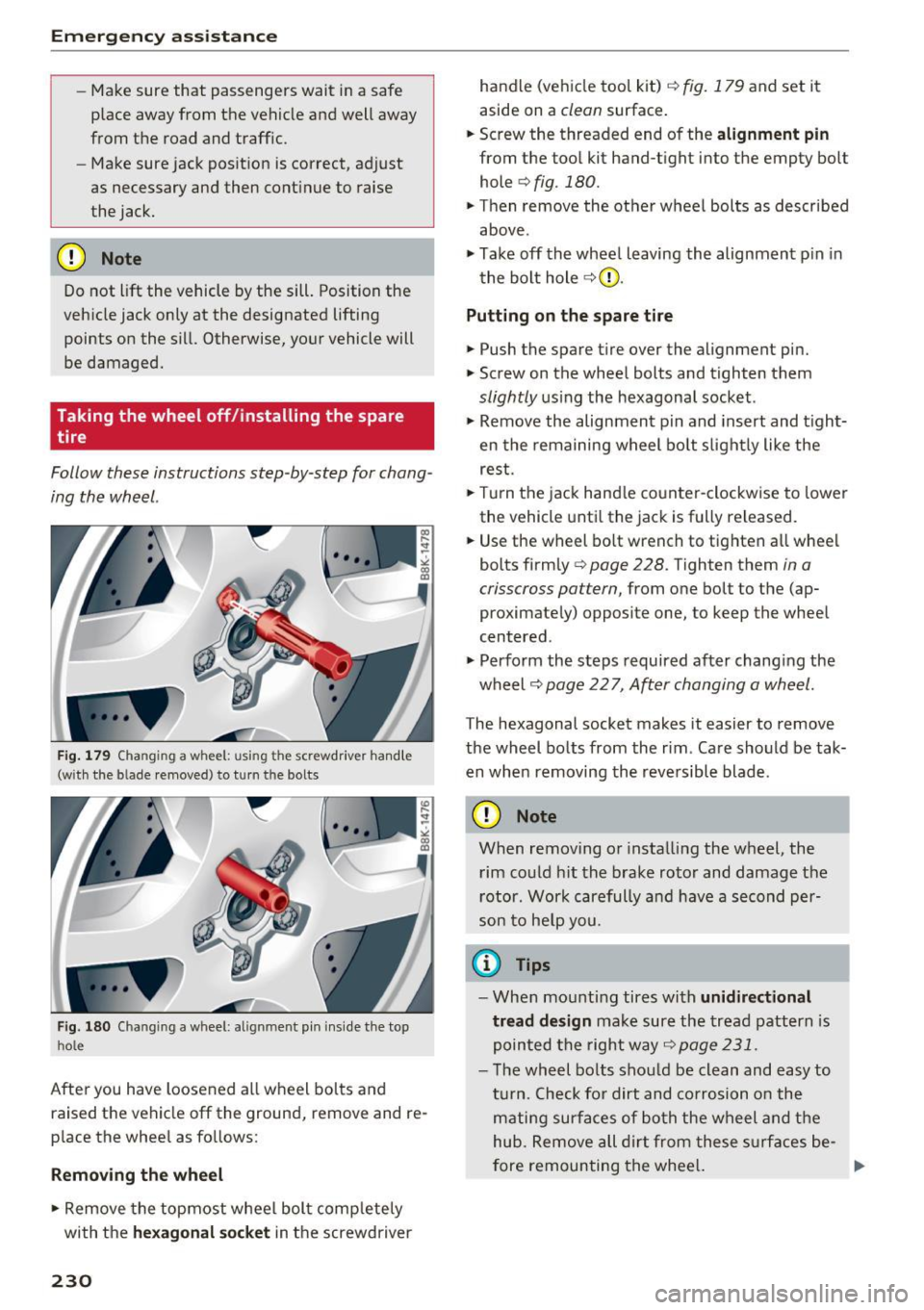
Emergency assistance
-Make sure that passengers wait in a safe
place away from the vehicle and well away
from the road and traff ic.
- Make sure jack position is correct, adjust
as necessary and then cont inue to raise
the jack.
(D Note
Do not lift the vehicle by the sill. Position the
vehicle jack only at the designated lifting points on the sill. Otherwise, your vehicle will
be damaged.
Taking the wheel off /installing the spare
tire
Follow these instructions step-by-step for chang
ing the wheel .
Fig. 179 Changing a wheel: using the screwdriver handl e
(with the blade removed) to turn the bolts
Fig. 180 Changing a wheel: alignment pin insid e the top
hole
After you have loosened all wheel bolts and raised the vehicle off the ground, remove and re
place the whee l as follows:
Removing the wheel
• Remove the topmost wheel bolt comp letely
with the
hexagonal socket in the screwdriver
230
handle (vehicle tool kit) ¢ fig. 179 and set it
aside on a
clean surface.
• Screw the threaded end of the
alignment pin
from the tool kit hand-tight into the empty bolt
hole ¢
fig. 180.
• Then remove the other wheel bolts as described
above.
• Takeoff the whee l leaving the alignment pin in
the bolt hole¢ (!).
Putting on the spare tire
• Push the spare tire over the alignment pin.
• Screw on the wheel bolts and tighten them
slightly using the hexagonal socket.
• Remove the alignment pin and insert and t ight
en the remaining wheel bolt slightly like the
rest.
• Tur n the jack hand le counter-clockw ise to lower
the vehicle until the jack is fully released.
• Use the wheel bolt wrench to tighten a ll wheel
bolts firmly ¢
page 228. Tighten them in a
crisscross pattern,
from one bolt to the (ap
proximately) opposite one, to keep the wheel
centered.
• Perform the steps required after chang ing the
wheel¢
page 227, A~er changing a wheel.
The hexagonal socket makes it easier to remove
the wheel bo lts from the rim . Care should be tak
en when removing the reversible blade.
(D Note
When removing or installing the wheel, the
rim could hit the brake rotor and damage the
rotor . Work carefully and have a second per
son to help you.
(D Tips
-When mounting tires with unidirectional
tread design
make sure the tread pattern is
pointed the right way¢
page 231.
-The wheel bolts should be clean and easy to
turn. Check for dirt and corrosion on the
mating surfaces of both the wheel and the
hub. Remove all dirt from these surfaces be
fore remounting the wheel.
Page 233 of 264

.... N
0 I-co ....
screwdriver handle to loosen or tighten the
wheel bolts.
Tires with unidirectional tread design
Tires with unidirectional tread design must be
mounted with their tread pattern pointed in the
right direction.
Using a spare tire with a tread pattern
intended for use in a specific direction
When using a spare tire with a tread pattern in
tended for use in a specific direction, please note
the following:
- The direction of rotation is marked by an
arrow
on the side of the tire.
-If the spare tire has to be installed in the incor
rect direction, use the spare tire only tempora
rily since the tire w ill not be ab le to achieve its
opt imum performance character istics with re
gard to aquaplaning, noise and wear.
- We recommend that you pay particular atten
t ion to this fact during wet weather and that
you adjust your speed to match road condi
t ions.
- Replace the f lat t ire with a new one and have it
installed on your vehicle as soon as possible to
restore the hand ling advantages of a unidirec
t iona l tire.
Notes on wheel changing
Pl ease read the informat ion ~page 212, New
tires or wheels
if you are going to use a spare tire
which is different from the tires on your vehicle.
After you change a tire :
-Check the tire pressure on the spare immedi
ately after installation.
- Have the wheel bolt tightening torque
checked with a torque wrench as soon as pos
sible by your authorized Audi dealer or quali
fied workshop.
- With steel and alloy wheel rims, the wheel
bolts are correctly tightened at a torque of 90
ft lbs . (120 Nm) .
Emergency assistance
-If you notice that the wheel bolts are corroded
and difficult to turn while changing a tire,
they should be replaced before you check the
tightening torque.
- Replace the flat tire with a new one and have
it installed on your vehicle as soon as possi
ble. Remount the wheel cover.
Until then , drive with extra care and at reduced
speeds.
A WARNING
-
- If you are going to equip your vehicle with
tires or rims which differ from those which
were factory installed, then be sure to read
the information
¢ page 212, New tires or
wheels.
- Always make sure the damaged wheel or
even a flat tire and the jack and tool kit are
proper ly secured in the luggage compart
ment and are not loose in the passenger
compa rtment .
- In an accident or sudden maneuver they
could fly forward, injuring anyone in the ve
hicle.
- Always store damaged wheel, jack and tools
securely in the luggage compartment. Oth
erwise, in an acc ident or sudden maneuver
they could fly forward, causing injury to pas
sengers in the veh icle.
(D Note
Do not use commerc ially available tire seal
ants. Otherwise, the electr ical components of
the tire press ure monitoring system * will no
l onger work properly and the sensor for the
tire pressure monitoring system* wi ll have to
be replaced by qualified workshop.
231
Page 234 of 264
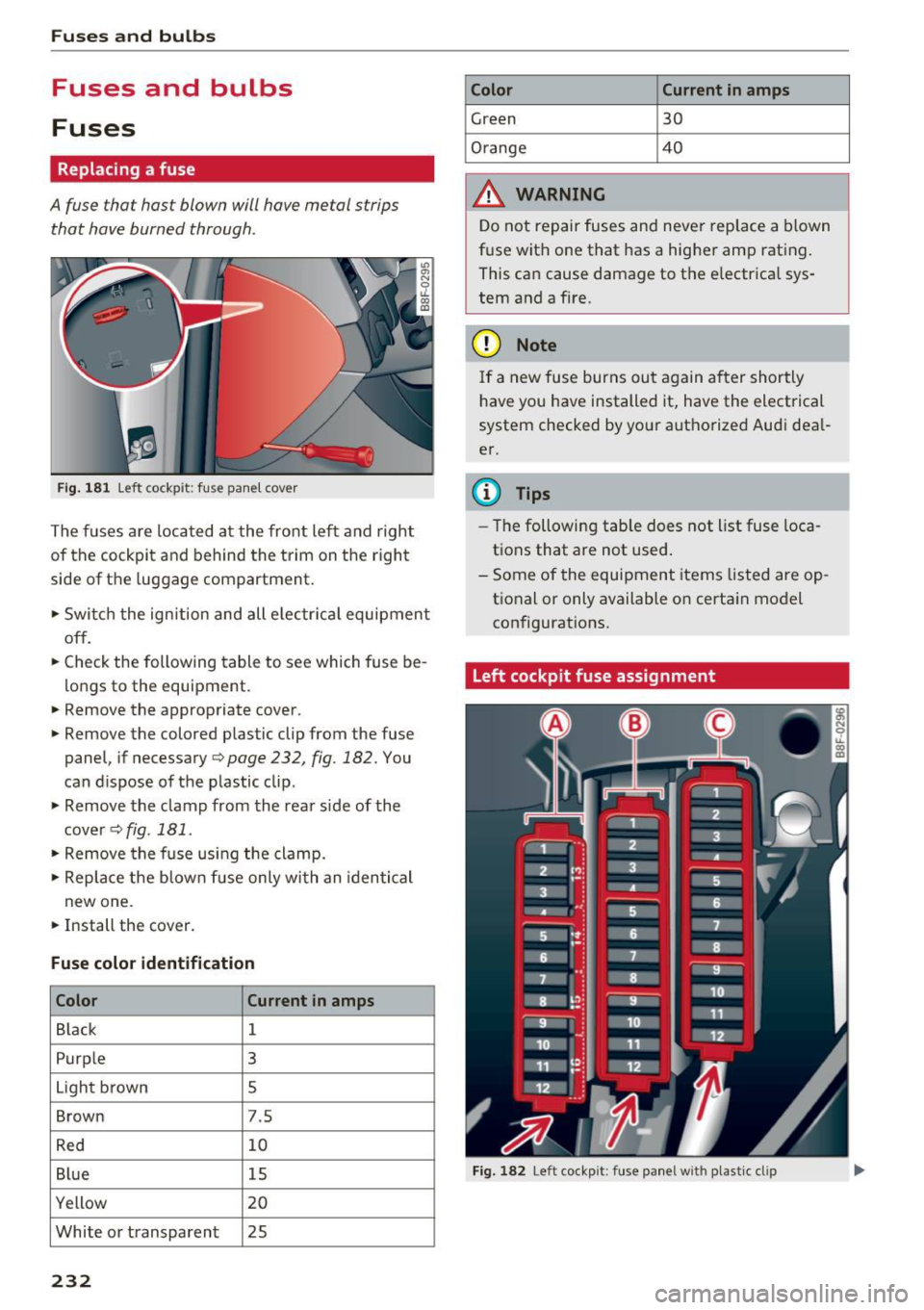
Fuses and bulbs
Fuses and bulbs
Fuses
Replacing a fuse
A fuse that hast blown will have metal strips
that have burned through .
Fig. 181 Left cockpit: fuse panel cover
The fuses are located at the front left and right
of the cockpit and behind the trim on the right
side of the luggage compartment.
• Switch the ignition and all electr ical equipment
off.
• Check the following table to see which fuse be
longs to the equipment.
• Remove the appropriate cover.
• Remove the colored plastic clip from the fuse
panel, if necessary
¢page 232, fig. 182. You
can dispose of the plastic clip.
• Remove the clamp from the rear side of the
cover ¢
fig. 181.
• Remove the fuse using the clamp.
• Replace the blown fuse only with an identical
new one.
• Install the cover.
Fuse color identification
Color Current in
amps
Black 1
Purple 3
Light brown 5
Brown 7.5
Red 10
Blue 15
Yellow 20
White or transparent 25
232
Color Current in amps
Green 30
Orange 40
A WARNING
Do not repair fuses and never replace a blown
fuse with one that has a higher amp rating.
This can cause damage to the e lectrica l sys
tem and a fire.
(D Note
If a new fuse burns out again after shortly
have you have installed it, have the electrical
system checked by your authorized Audi deal
er.
(D Tips
- The following table does not list fuse loca
tions that are not used.
- Some of the equipment items listed are op
tional or only available on certain model configurations.
Left cockpit fuse assignment
Fig. 182 Left cockpit : fuse panel with plastic clip
Page 235 of 264

..... N
0 1-CX)
rl I.Cl U"I
..... I.Cl ......
Fuse panel @ (black)
No . Consumer
1 Dynamic steering
2 Electronic Stabilization Cont rol (mod ule)
A/C system press ure sensor, elect rome -
chan ica l park ing brake , Homelink, auto-
3 mat
ic dimming interior rear v iew mirror,
air q uality/outside a ir sensor, Electronic
Stabili zation Cont rol (button)
5 Sound actuator
6 Headlight range control/
headlight (cor-
ne ring light)
7 Headlight (corner ing light)
Con trol modules (e lectrom echan ica l par k-
8 ing brake , s hock ab so rbe r, q uattro s port),
DCDC converter
9 Adapt ive cru ise control
1 0 Shift ga te/clu tch se nsor
1 1 Side assist
12 Headlight range control
, p arkin g sys tem
13 Airbag
14 Rear wiper (a
llroad)
1 5 Auxiliary fuse (instrument panel)
1 6 Auxiliary fuse terminal 15 (engine area
)
Fuse panel@ (brown)
No . Consumer
2 Brake light senso r
3 Fuel pump
4 Clutch sensor
5
Left seat heating w it h /w it h out seat venti-
l a tion
6 Electronic Stabili zation Cont rol (e lectr ic)
7 Ho rn
8
F ront left door (window regulator, central
locki ng, mirror, switch, lig hting)
9 Windshield wiper moto r
10 Electronic Stabilization Cont rol (va lves)
Fuses and bulbs
No . Consumer
Two-door mode ls: rear left w indow reg ula-
1 1 tor; Four-door mode
ls: rear left door (w in-
dow regu lator, central locking, switch,
li ght ing)
1 2 Rain and
light sensor
Fuse panel © (red)
No . Consumer
3 Lumbar support
4 Dynam ic steering
5 Inter
io r ligh ting ( Cabr io let)
6 W
indshie ld washer system, headlight
wash er system
7 Vehicle e lectrica l system control module 1
8 Ve hicl e e lec trica l sy stem con trol module 1
9
Left rear window regu lator motor (Cabr io-
l et)/s unroof
1 0 Vehicle e lec tric al system con trol module 1
1 1 R
ight rear window regulator (Cabriolet)/
su n shade motor
1 2 A
nti- theft alarm warning system
Right cockpit fuse assignment
Fig. 183 R ig h t cockp it : f use pane l wit h plast ic cl ip
233
Page 236 of 264
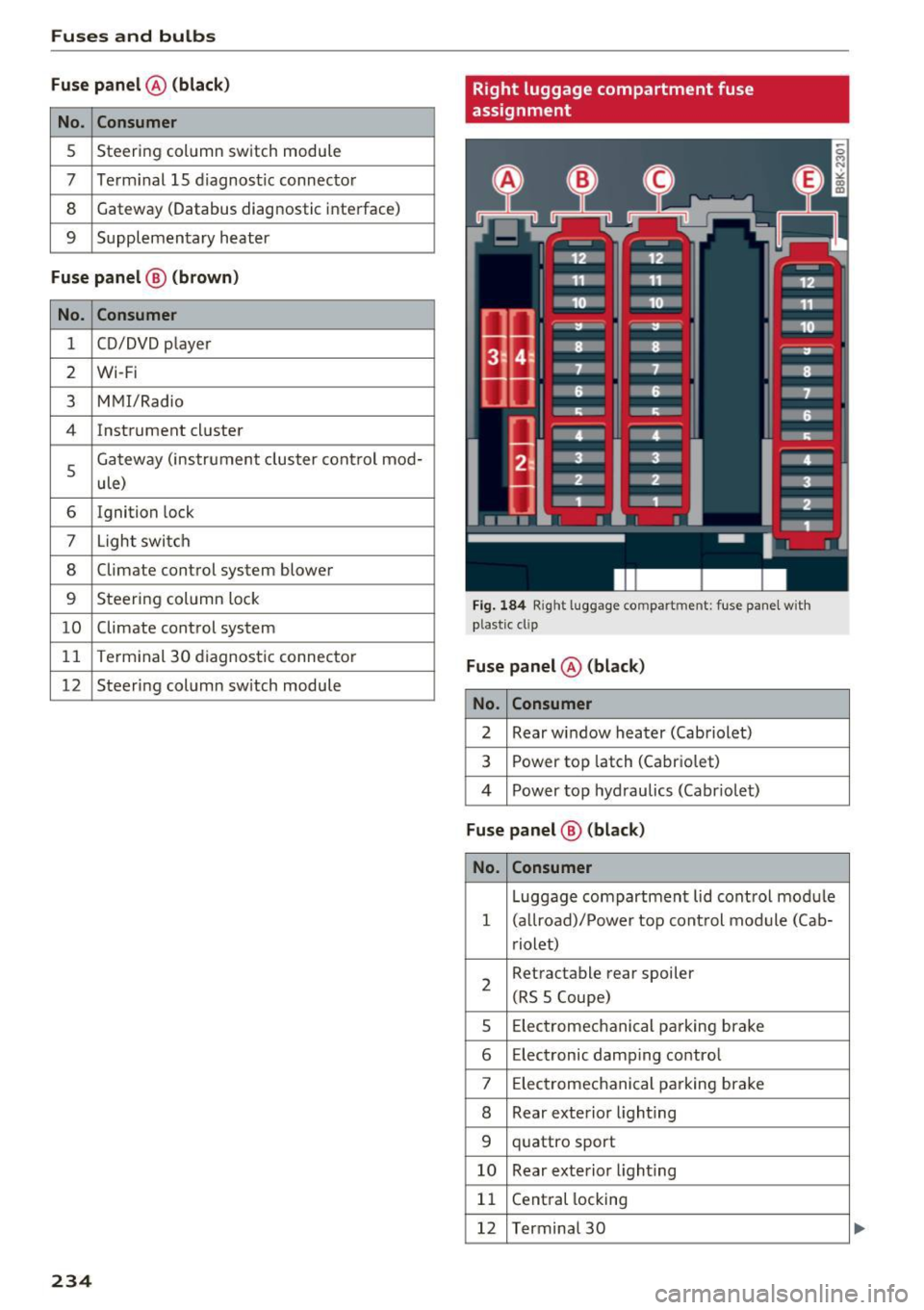
Fuses and bulbs
Fuse panel @ (black )
No. Consume r
5 Steering column switch module
7 Term inal 15 diagnostic connec to r
8 Gateway (Databus diagnostic interface)
9 S upplementary heater
Fuse panel @ (brown)
No. Consumer
1 C D/D VD p laye r
2 Wi-Fi
3 M MI/Radio
4 Instrument cluster
5
Ga teway (instrument cluster cont rol mod -
ule)
6 Ignition lock
7 Ligh t swi tch
8 Climate control system blower
9 Steering col umn lock
10 Climate control system
1 1 Te
rm inal 30 diagnos tic connec to r
12 Steer ing column sw itch module
234
Right luggage compartment fuse
assignment
Fig. 184 Right lu ggage compartment: fuse panel wit h
plast ic cl ip
Fuse panel @ (black)
No . Consumer
2 Rear wi ndow heater (Cabriolet)
3 Power top latch (Cabr io let)
4 P ower top hyd raulics (Cabr io let)
Fuse panel @ (black)
No . Consumer
Luggage compartment lid cont rol mo dule
1 (all road)/ Power top cont rol mod ule (Ca b-
r iolet)
2 Retractable rear
spoiler
(RS 5 Coupe)
5 E
lec tromec hanical p arking brake
6 Electronic damping contro l
7 Elec tromec hanical pa rking brake
8 Rear exte rior light ing
9 q uattro sport
10 Rear exterior lighting
1 1 Cent
ral locking
12 Terminal 30
...
Page 237 of 264
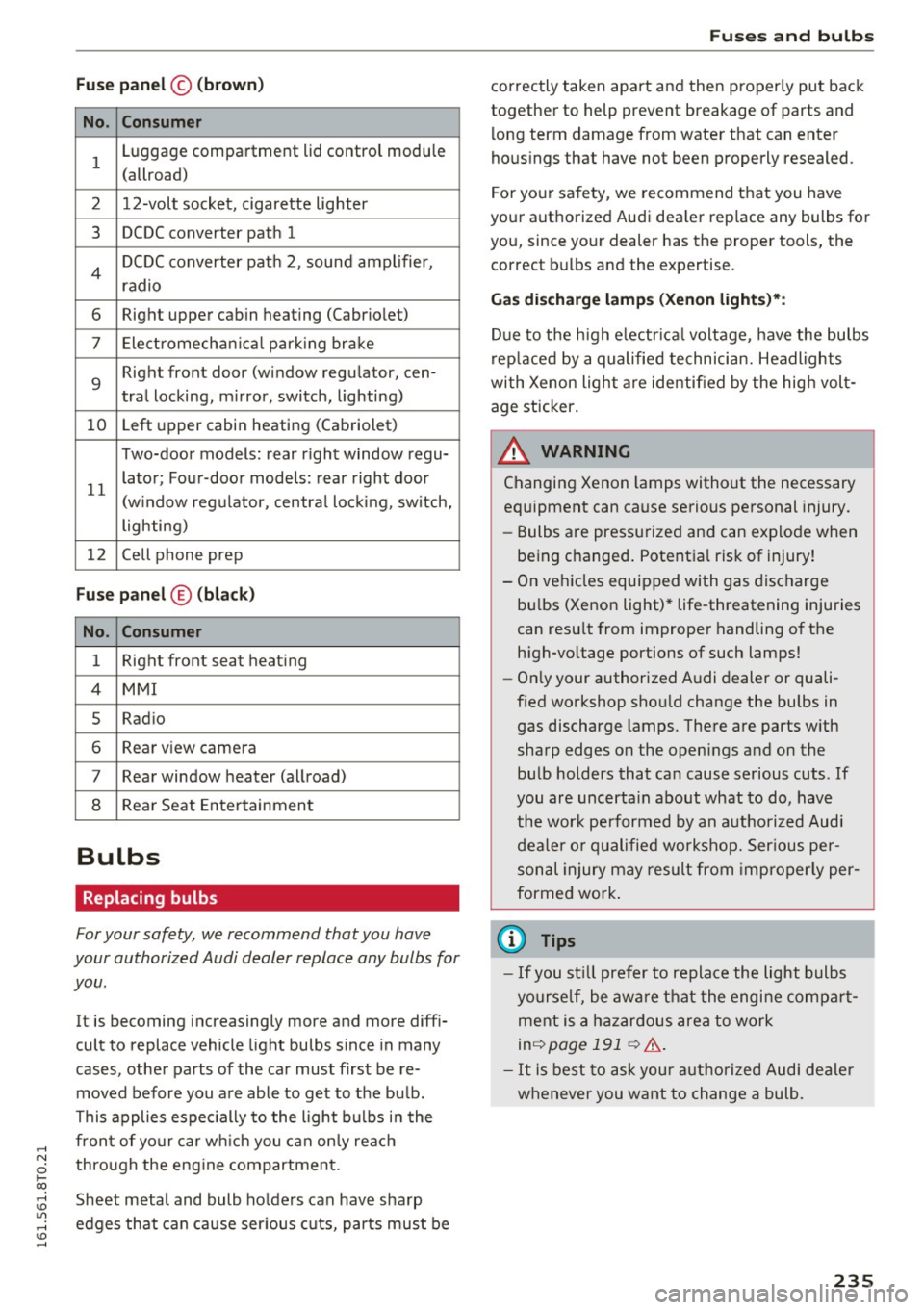
.... N
0 Ico ....
No . Consumer
1 Luggage compartment lid control module
(allroad)
2 12-volt socket, cigarette lighter
3 DCDC converter path 1
4 DCDC converter path 2, sound amplifier,
radio
6 Right upper cabin heating (Cabriolet)
7 Elect romechan ical park ing brake
9
Right front door (window regulator, cen-
tral locking, m irror, switch, lighting)
10 Left
upper cabin heating (Cabriolet)
Two-door models: rear r ight window regu-
11 lator; Four-door models:
rear right door
(w indow regulator, central locking, switch,
lighting)
12 Cell phone prep
Fuse panel ® (black )
No . Consumer
1 Right front seat
heating
4 MMI
5 Radio
6 Rear view camera
7 Rear window heater (allroad)
8 Rear Seat Entertainment
Bulbs
Replacing bulbs
For your safety, we recommend that you have
your authorized Audi dealer replace any bulbs for
you .
It is becoming increasingly more and more diffi
cult to replace vehicle light bulbs since in many
cases, other parts of the car must first be re
moved before you are able to get to the bu lb.
This applies especially to the light bulbs in the
front of your car which you can only reach
through the eng ine compartment.
Sheet metal and bulb ho lders can have sharp
edges that can cause serious cuts, parts must be
Fuses and bulbs
correctly taken apart and then properly put back
together to help prevent breakage of parts and
long term damage from water that can enter
hous ings that have not been properly resealed.
For your sa fety, we recommend that you have
your authorized Audi dea ler replace any bulbs for
you, since your dealer has the proper tools, the
correct bulbs and the expertise.
Gas discharge lamps (Xenon lights)*:
Due to the high e lectr ica l voltage, have the bulbs
replaced by a qualified technician. Headlights
with Xenon light are identified by the high volt
age sticker .
A WARNING
Changing Xenon lamps without the necessary
equipment can cause serious personal injury.
- Bulbs are pressurized and can explode when
being changed . Potential risk of injury!
- On vehicles equipped with gas discharge
bu lbs (Xenon light)* life-threatening injuries
can resu lt from improper handling of the
high -vo ltage portions of such lamps!
- Only your authorized Audi dealer or quali
fied workshop shou ld change the bulbs in
gas discharge lamps. There are parts w ith
sharp edges on the openings and on the bulb holders that can cause serious cuts . If
you are uncerta in about what to do, have
the wor k performed by an authorized Audi
dealer or qualified workshop. Serious per
sonal injury may result from improperly per
formed work.
(D Tips
- If you st ill prefer to replace the light bulbs
yourself, be awa re that the engine compa rt
ment is a hazardous area to work
inq page191 q &_ .
-It is best to ask your authorized Audi dealer
whenever you want to change a bulb.
235
Page 238 of 264
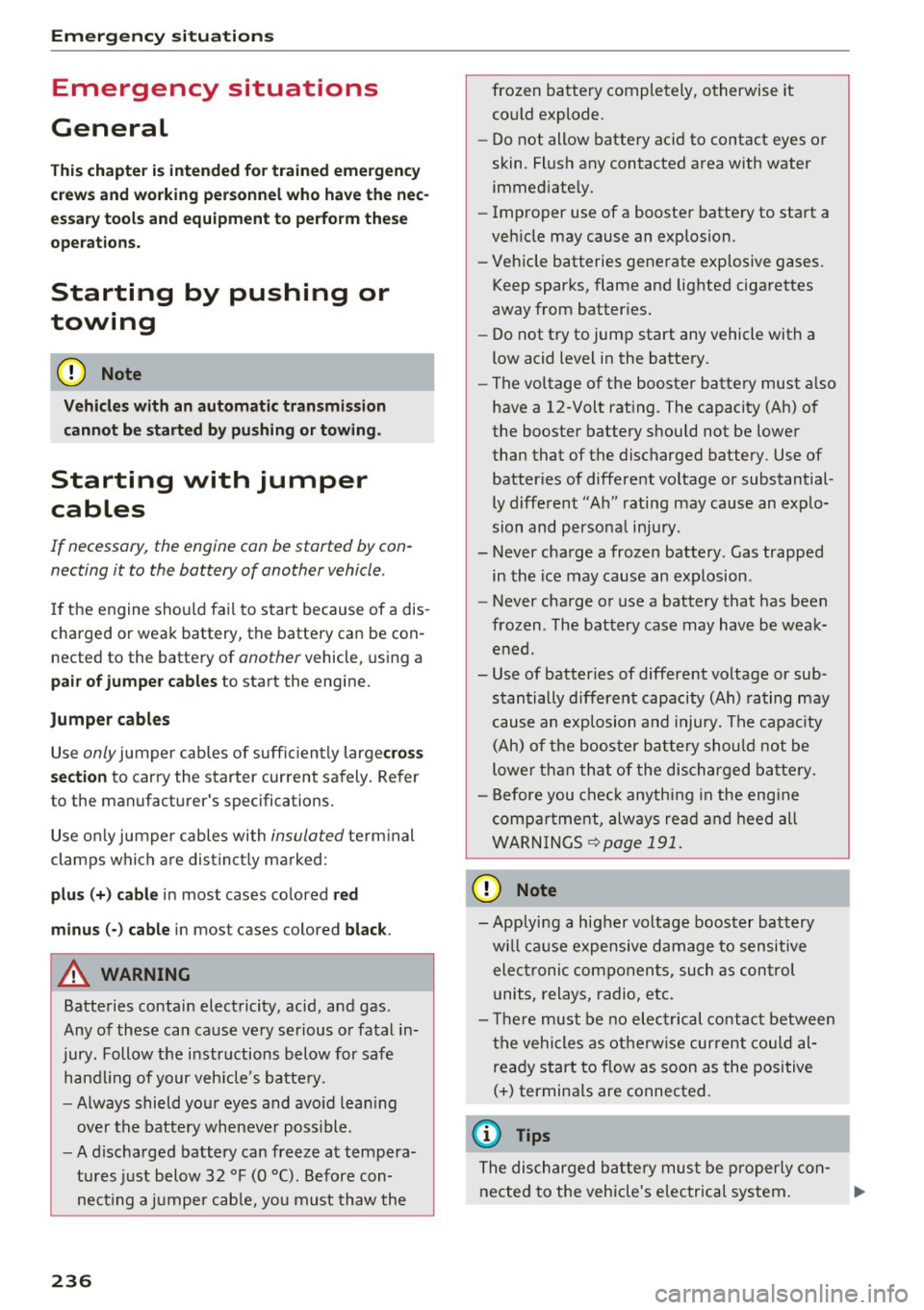
Emergency situations
Emergency situations
General
This chapter is intended for trained emergency crews and working personnel who have the nec
essary tools and equipment to perform these
operations.
Starting by pushing or
towing
CD Note
Vehicles with an automatic transmission
cannot be started by pushing or towing.
Starting with jumper
cables
If necessary, the engine con be started by con
necting it to the battery of another vehicle.
If the engine should fail to start because of a dis
charged or weak battery, the battery can be con
nected to the battery of
another vehicle, using a
pair of jumper cables to start the engine.
Jumper cables
Use only jumper cables of sufficiently largecross
section
to carry the starter current safely. Refer
to the manufacturer's specifications.
Use only jumper cables with
insulated terminal
clamps which are distinctly marked :
plus(+) cable in most cases colored red
minus(-) cable
in most cases colored black.
A WARNING
Batteries contain electricity, acid, and gas.
Any of these can cause very serious or fatal in
jury. Follow the instructions below for
safe
handling of your vehicle's battery.
-Always shield your eyes and avoid leaning
over the battery whenever possible.
-A discharged battery can freeze at tempera
tures just below 32 °F (0 °C). Before con
necting a jumper cable, you must thaw the
236
frozen battery completely, otherwise it could explode.
- Do not allow battery acid to contact eyes or
skin. Flush any contacted area with water immediately.
- Improper use of a booster battery to start a
vehicle may cause an explosion.
- Vehicle batteries generate explosive gases.
Keep sparks, flame and lighted cigarettes
away from batteries.
- Do not try to jump start any vehicle with a
low acid level in the battery.
- The voltage of the booster battery must also
have a 12-Volt rating. The capacity (Ah) of
the booster battery should not be lower
than that of the discharged battery. Use of
batteries of different voltage or substantial
ly different "Ah" rating may cause an explo
sion and personal injury.
- Never charge a frozen battery. Gas trapped in the ice may cause an explosion.
- Never charge or use a battery that has been
frozen . The battery
case may have be weak
ened .
- Use of batteries of different voltage or sub
stantially different capacity (Ah) rating may
cause an explosion and injury. The capacity
(Ah) of the booster battery should not be
lower than that of the discharged battery.
- Before you check anything in the engine
compartment, always read and heed all
WARNINGS
~page 191.
CD Note
-Applying a higher voltage booster battery
will cause expensive damage to sensitive
electronic components, such as control
units, relays, radio, etc.
- There must be no electrical contact between
the vehicles as otherwise current could al
ready start to flow as soon as the positive
(+) terminals are connected.
@ Tips
The discharged battery must be properly con-
nected to the vehicle's electrical system. .,..
Page 239 of 264
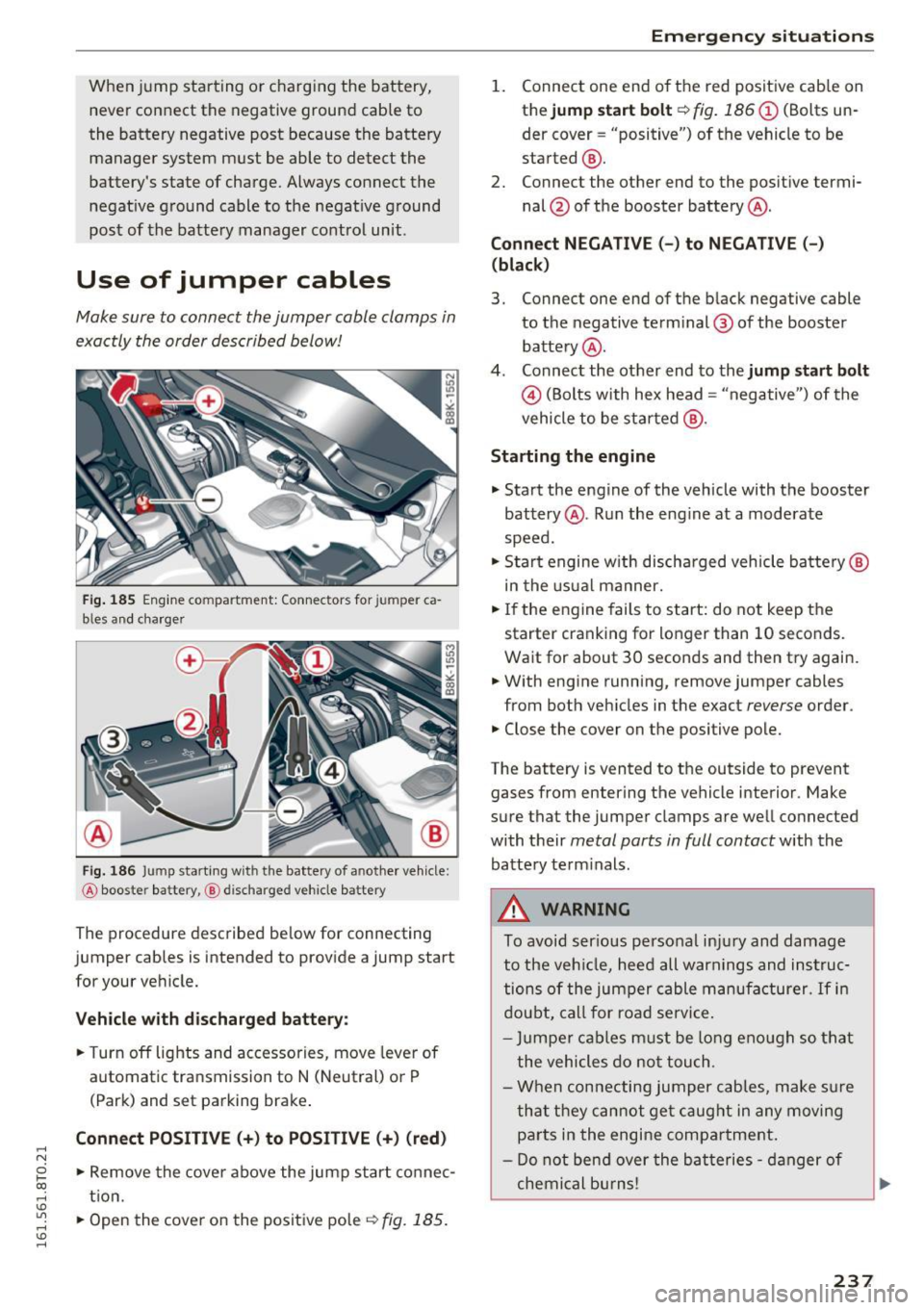
,-1 N
0 1-CX)
,-1 I.Cl U"I
,-1 I.Cl ......
When jump starting or charging the battery,
never connect the negative ground cable to
the battery negative post because the battery
manager system must be able to detect the
battery's state of charge . Always connect the
negative ground cable to the negat ive ground
post of the battery manager control unit .
Use of jumper cables
Make sure to connect the jumper cable clamps in
exactly the order described below!
Fig. 185 Engine compa rtment: Connectors for jumper ca
b les and cha rge r
Fig. 186 Jump start ing with the battery of another vehicle:
@ boos te r ba ttery, ® d ischarged veh icle ba ttery
The procedure described below for connecting
jumper cables is intended to provide a jump start
for your vehicle.
Vehicle with discharged battery:
.. Turn off lights and accessories, move lever of
automatic transmission to N (Neutral) or P
(Park) and set parking brake .
Connect POSITIVE(+) to POSITIVE(+) (red)
.,. Remove the cover above the jump start connec
t ion.
.,. Open the cover on the positive pole¢
fig. 185.
Emergency situations
1. Connect one end of the red positive cab le on
the
jump start bolt¢ fig. 186 (D (Bolts un
der cover= "positive") of the vehicle to be
started @.
2. Connect the other end to the positive termi- nal@of the booster battery @.
Connect NEGATIVE (-) to NEGATIVE (- )
(black)
3. Connect one end of the black negative cable
to the negative terminal @ of the booster
battery @.
4 . Connect the other end to the
jump start bolt
@(Bolts with hex head= "negative") of the
vehicle to be started @.
Starting the engine
.. Start the engine of the vehicle with the booster
battery @. Run the eng ine at a moderate
speed .
.,. Start engine w ith discharged vehicle battery @
in the usual manner.
.,. If the engine fails to start: do not keep the
starter cranking for longer than 10 seconds.
Wait for about 30 seconds and then try again .
.. With engine running, remove jumper cables
from both vehicles in the exact
reverse order .
.. Close the cover on the positive pole.
The battery is vented to the outside to prevent gases from entering the vehicle interior . Make
sure that the jumper clamps are well connected
with their
metal parts in full contact with the
battery term inals .
A WARNING
To avoid ser ious personal injury and damage
to the vehicle, heed all warnings and instruc
tions of the jumper cable manufacturer.
If in
doubt, call for road service.
- Jumper cables must be long enough so that
the vehicles do not touch .
- When connecting jumper cables, make s ure
that they cannot get caug ht in any moving
parts in the engine compartment.
- Do not bend over the batteries -danger of
chemical bu rns!
237
Page 240 of 264
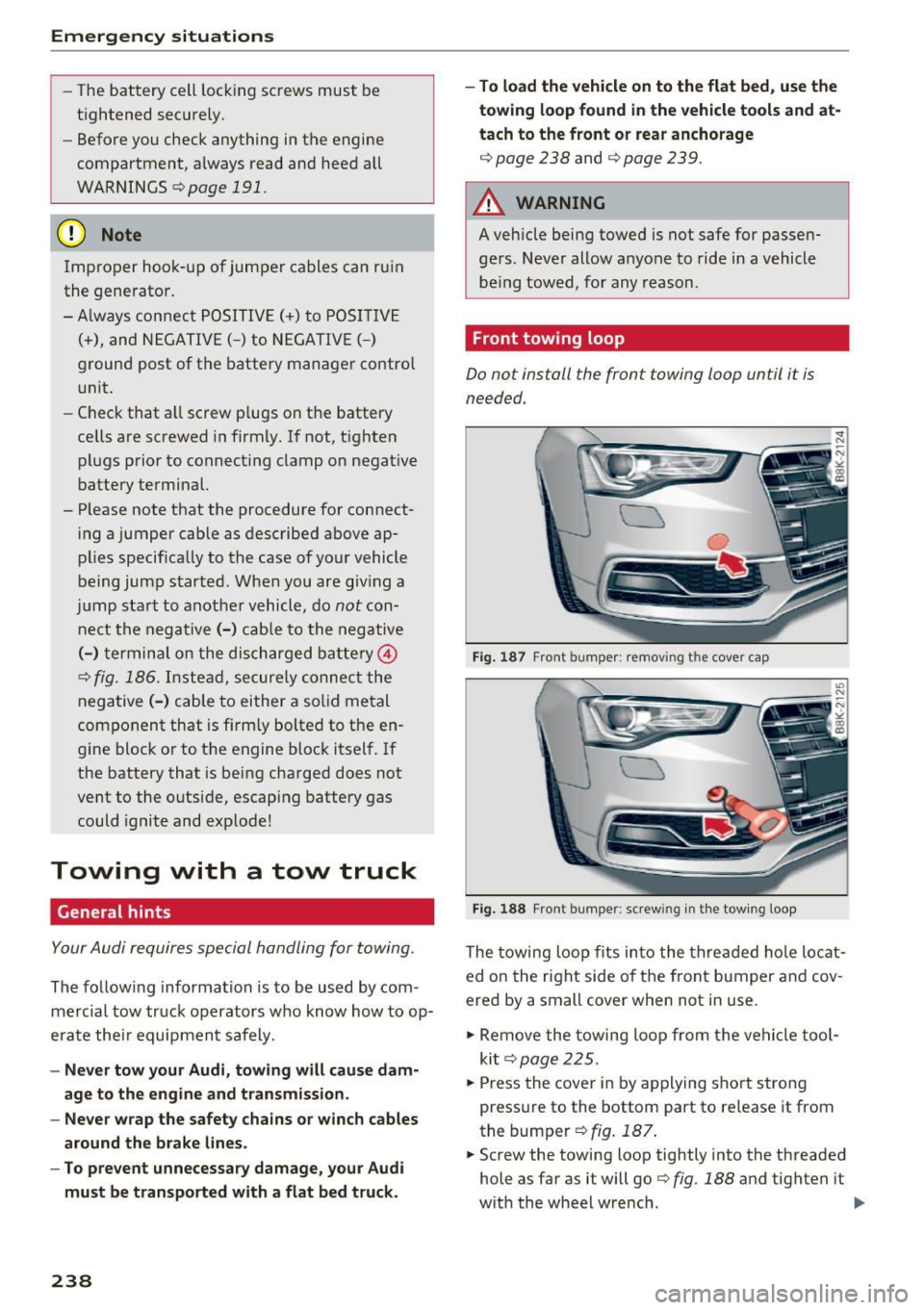
Emergency situations
-The battery cell locking screws must be
tightened securely .
- Before you check anything in the engine
compartment, always read and heed all
WARNINGS
c> page 191.
(D Note
Improper hook-up of jumper cables can ruin
the generator.
- A lways connect POSITIVE(+) to POSITIVE
(+), and NEGATIVE(-) to NEGATIVE(-)
ground post of the battery manager control
unit.
- Check that a ll screw plugs on the battery
cells are screwed in firmly. If not, tighten
plugs prior to connecting clamp on negative
battery terminal.
- Please note that the procedure for connect
ing a jumper cable as described above ap
plies specif ically to the case of your vehicle
being jump started . When you are giv ing a
jump start to another vehicle, do
not con
nect the negative(-) cable to the negative
(-) terminal on the discharged battery @
c> fig. 186. Instead, securely connect the
negative (-) cab le to either a solid metal
component that is firm ly bolted to the en
gine block or to the engine block itself. If
the battery that is being charged does not
vent to the outside , escap ing battery gas
could ignite and explode!
Towing with a tow truck
General hint s
Your Audi requires special handling for towing.
The following information is to be used by com
mercial tow truck operators who know how to op
erate the ir equipment safely.
-Never tow your Audi, towing will cause dam
age to the engine and transmission.
- Never wrap the safety chains or winch cables
around the brake lines .
- To prevent unnecessary damage, your Audi
must be transported with a flat bed truck.
238
-To load the vehicle on to the flat bed, use the
towing loop found in the vehicle tools and at
tach to the front or rear anchorage
c> page 238 and c> page 239.
A WARNING
A veh icle being towed is not safe for passen
gers . Never allow anyone to ride in a vehicle
being towed, for any reason .
Front towing loop
Do not in stall the front towing loop un til i t is
needed .
Fig. 187 Front bumper: removing the cover cap
Fig. 188 Front bumper: s crew ing in t he towing loop
The towing loop fits into the threaded hole locat
ed on the right side of the front bumper and cov
ered by a small cover when not in use .
.,. Remove the towing loop from the vehicle tool
ki t
c> page 225 .
... Press the cover in by applying short strong
pressure to the bottom part to r elease it from
the bumper
c> fig. 187.
... Screw the towing loop tightly into the threaded
hole as far as i t will go
c> fig. 188 and tighten it
with the wheel wrench . ..,.